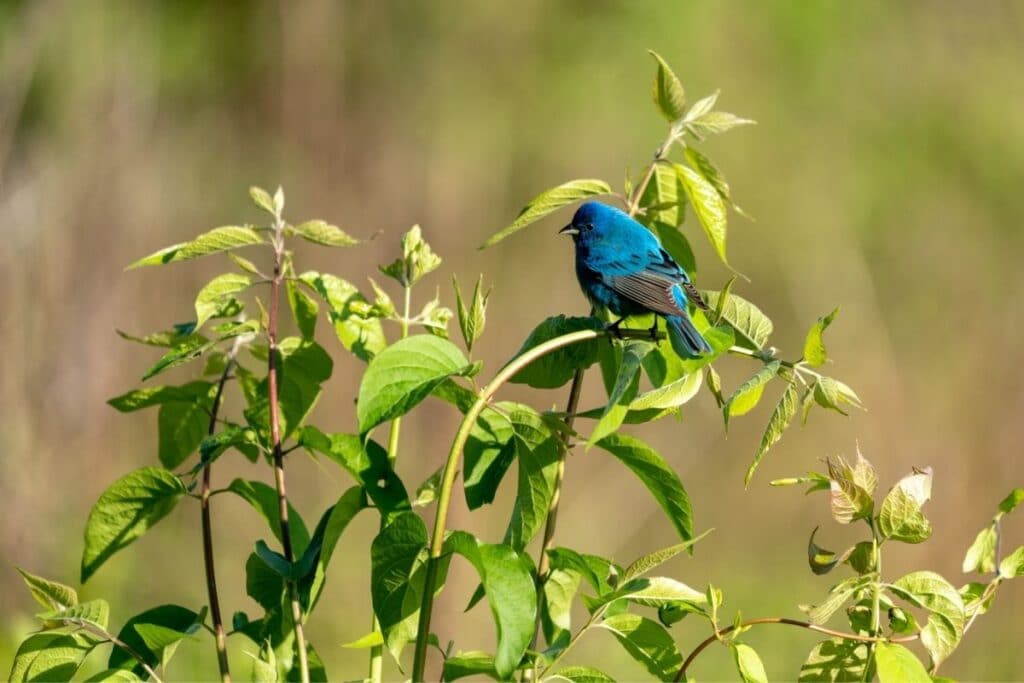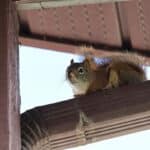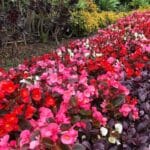If you’re a gardener, then you know how important it is to make your garden attractive to these blue birds.
Not only do they add beauty to your landscape, but they also help control insect populations. One of the most beautiful and interesting bird species that you can attract to your yard is the indigo bunting.
This post will tell you everything you need to know about how to attract indigo buntings to your yard.
Keep reading for tips on creating a birder’s paradise!
What Are Indigo Buntings?
Indigo buntings are a type of songbird native to North America. They are sometimes referred to as “blue canaries” or “blue finches”. These small, brightly-colored birds lack true blue pigment in their feathers. They reflect blue light beautifully, creating a stunning visual display. Indigo buntings eat small seeds, grains, fruits such as berries, and insects.
They are well known for the beautiful songs they produce, which are complex and melodic in nature.
In addition to being aesthetically pleasing, these songs also serve an important purpose, allowing indigo buntings to establish and maintain territories as well as attract mates. Because of their striking plumage and vocal abilities, indigo buntings are considered some of the most beloved songbirds in North America.
Moreover, they play an important role in ecosystem health by dispersing seeds and pollinating plants with their long beaks. Thus, while they may be relatively small in size, indigo buntings have a big impact on our world.
Why Are Indigo Buntings Beneficial?
Indigo buntings are one of the most common and widespread songbirds in North America. They are also one of the most beneficial, providing critical ecosystem services to both farmers and forest managers.
There are certain birds you should keep away from your garden, however, indigo bunting birds are the ones you will want to have.
One of the most important ways that indigo buntings benefit the environment is by controlling insect populations. Indigo buntings are particularly proficient at controlling crop-damaging insects such as corn borers, rootworms, and Japanese beetles.
In fact, a single pair of indigo buntings can consume more than 2,000 insects in a single nesting season. In addition to their role in pest control, indigo buntings are also important seed dispersers.
They play a key role in restoring native plant populations that have been impacted by habitat loss or fragmentation.
By dispersing seeds far and wide, indigo buntings help to ensure the long-term health of our forests and agricultural lands.
How to Attract Indigo Buntings
What kind of bird is blue with a black cap? If you said indigo bunting, you’re right! These shy birds are common in North America, and they can be easy to attract if you know what to do. Below, we’ll share some tips on how to make your backyard friendly for indigo buntings.
So keep reading to find out more!
How to Attract Indigo Buntings to Feeders
There are many things you can do to attract indigo buntings to your backyard bird feeders. The first step is to choose the right feeder, as this will make a big difference in terms of attracting these colorful little birds.
Opt for a feeder with multiple openings, as this will give indigo buntings easy access and allow them to see what kind of food other birds are getting.
You should also make sure that your bird feeders are well stocked with a variety of different foods, including sunflower seeds, thistle seeds, millet, and cracked corn.
And lastly, take the time to regularly clean out your feeders by scrubbing them with soap and water and leaving them outside so they can fully dry.
With these tips in mind, you will be well on your way to attracting indigo buntings and enjoying their beautiful songs in no time!
What Plants to Grow to Attract Indigo Buntings
The song of the indigo bunting is a beloved part of summertime in North America. These small, blue songbirds are relatively common, and their cheerful singing makes them a welcome addition to any backyard. If you’re looking to attract indigo buntings to your yard, there are a few things to keep in mind.
Firstly, these birds prefer open spaces such as fields and meadows.
They are also attracted to gardens with thick vegetation, as this provides them with shelter from predators. In terms of plants, they enjoy eating insects and seeds, so planting a variety of native plants will give them the food they need.
Good choices include sunflowers, thistle, and black-eyed Susan. By providing the right habitat and food source, you can bring the beauty of indigo buntings to your own backyard.
Provide Indigo Buntings With Mealworms
Mealworms are an important food source for Indigo Buntings. These small, worm-like creatures are high in protein and fat, making them an excellent food for growing chicks. You can purchase mealworms online or at your local pet store.
You can also start your own colony by keeping a few chickens or feeding scraps to wild birds.
If you provide mealworms for Indigo Buntings, you will be sure to attract these beautiful birds to your backyard!
Make Sure There’s Water Available
In order to survive, all living creatures need a constant supply of water. But for indigo buntings in particular, access to clean, fresh water is absolutely essential.
These beautiful songbirds are highly adapted to life in arid environments, with long bills and narrow nostrils that help them extract even the smallest droplets from soil and plants.
Therefore, it is critical that we make sure there is adequate water available for these precious birds, whether through dedicated wildlife ponds or through simple conservation measures like rainwater collection or mulching.
You can even put out some shallow dishes of water, if you choose, to make sure these birds have the water they need.
Go Organic in Your Garden
If you’re passionate about birdwatching, you may want to consider making your garden more inviting to feathered friends by going organic. Chemical pesticides can be harmful to birds, as well as other wildlife, and can even contaminate the soil and water.
On the other hand, organic methods such as using mulch, compost, and beneficial insects can create a safe haven for indigo buntings and other blue birds.
In addition, organic gardens are often more beautiful, as they attract butterflies, bees, and other pollinators. So if you’re looking to create a haven for feathered friends, going organic is the way to go.
Leave Nests Be
It is important that we be careful not to disturb any potential indigo bunting nests if we happen across them in our travels.
If we are too rough with the fragile brambles and branches where they build their nests, we run the risk of destroying the delicate structures or frightening off both parents before they have a chance to properly fledge their young. So while it might be tempting to want to get up close and personal with these beautiful birds, we must resist the urge, and allow these wondrous wonders of nature their peace and quiet.
Put Out a Birdbath
Keeping a birdbath in your yard can be a great way to attract indigo buntings. These beautiful birds rely on water sources for drinking and bathing, and having a birdbath on your property can provide an ideal site for them to spend time.
Furthermore, birdbaths can help to keep the rest of your lawn or garden moist by providing a place for excess rainwater to evaporate. And since indigo buntings are known for their bright colors and sweet song, putting out a birdbath will not only attract these beautiful birds, but it will also help to beautify your outdoor space.
Whether you’re looking to enjoy some fascinating wildlife sightings or simply want to add some extra beauty to your yard, putting out a birdbath is the perfect way to do so.
Be Patient – They Can Be Hard to Spot!
Although these birds are generally abundant, their plumage makes them notoriously difficult to spot. Not all buntings have the telltale blue plumage – females have hazelnut brown tails that allow them to blend in easily with the surrounding environment.
Plus, indigo buntings are known for being rather shy and wary of humans, making them challenging to observe even in the best of circumstances. Many bird watchers describe their attempts to spot indigo bunting as a kind of game – they spend time scanning the skies and trying to track individual birds as they flit between trees or perch on branches.
However, despite these challenges, many people consider the indigo bunting to be worth the effort. This little songbird is not only beautiful but also a talented singer with a complex repertoire of calls and songs – truly a sight to behold.
So if you’re patient enough, keep your eyes peeled and don’t give up hope – you may just get lucky before long!
FAQs
What is the best bird feeder for buntings?
The best bird feeder for buntings, including Indigo Buntings, is one that offers a selection of small seeds such as nyjer or thistle, as well as sunflower seeds and millet. Tube feeders with small feeding ports or mesh feeders work well for providing these types of seeds.
What does it mean if you see an indigo bunting?
Seeing an Indigo Bunting can be considered a treat for bird watchers, as these birds are known for their stunning blue plumage and cheerful songs. Some people believe that seeing an Indigo Bunting is a symbol of good fortune or positive change, while others simply enjoy the beauty of these birds.
How long do Indigo Buntings live for?
Indigo Buntings typically live for about 3-5 years in the wild. However, with favorable conditions and luck, they can live longer, with some individuals recorded living up to 8-10 years.
Final Words
If you want to attract painted buntings, you need to begin to think holistically about your garden.
By following these simple tips, you can bring these beautiful birds into your backyard and enjoy their company while they feast on the natural bounty of your property.
See more: How to keep crows away
*image by Wirestock/depositphotos







